
A mushroom or toadstool is the fleshy, spore-bearing fruiting body of a fungus, typically produced above ground, on soil, or on its food source. Toadstool generally denotes one poisonous to humans.

Agaricus bisporus, commonly known as the cultivated mushroom, is a basidiomycete mushroom native to grasslands in Eurasia and North America. It is cultivated in more than 70 countries and is one of the most commonly and widely consumed mushrooms in the world. It has two color states while immature – white and brown – both of which have various names, with additional names for the mature state, such as chestnut, portobello, portabellini, button and champignon de Paris.
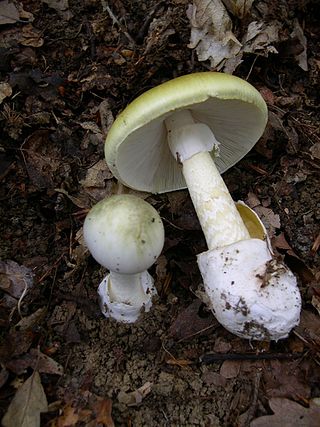
Mushroom poisoning is poisoning resulting from the ingestion of mushrooms that contain toxic substances. Symptoms can vary from slight gastrointestinal discomfort to death in about 10 days. Mushroom toxins are secondary metabolites produced by the fungus.
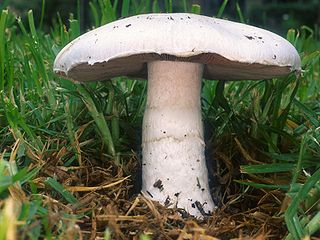
The Agaricaceae are a family of basidiomycete fungi and include the genus Agaricus, as well as basidiomycetes previously classified in the families Tulostomataceae, Lepiotaceae, and Lycoperdaceae.

Agaricus xanthodermus, commonly known as the yellow-staining agaricus, yellow-staining mushroom or yellow-stainer, is a mushroom of the genus Agaricus, which displays a strong yellow colouration at the base of the stem when cut. It has a phenolic smell. It is poisonous for most people, causing gastrointestinal upset, but can be eaten by some without apparent negative effect.

Agaricus is a genus of mushroom-forming fungi containing both edible and poisonous species, with over 400 members worldwide and possibly again as many disputed or newly-discovered species. The genus includes the common ("button") mushroom and the field mushroom, the dominant cultivated mushrooms of the West.

An agaric is a type of fungal fruiting body characterized by the presence of a pileus (cap) that is clearly differentiated from the stipe (stalk), with lamellae (gills) on the underside of the pileus. It is type of mushroom or toadstool, the diverse group of agarics being lumped together as gilled mushrooms. "Agaric" can also refer to a basidiomycete species characterized by an agaric-type fruiting body.

Russula is a very large genus composed of around 750 worldwide species of ectomycorrhizal mushrooms. They are typically common, fairly large, and brightly colored – making them one of the most recognizable genera among mycologists and mushroom collectors. Their distinguishing characteristics include usually brightly coloured caps, a white to dark yellow spore print, brittle, attached gills, an absence of latex, and absence of partial veil or volva tissue on the stem. Microscopically, the genus is characterised by the amyloid ornamented spores and flesh (trama) composed of spherocysts. Members of the related genus Lactarius have similar characteristics but emit a milky latex when their gills are broken. The genus was described by Christian Hendrik Persoon in 1796.
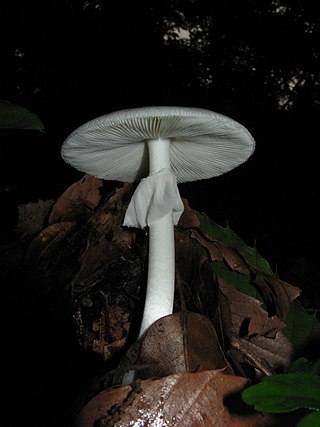
Amanita verna, commonly known as the fool's mushroom or the spring destroying angel, is a deadly poisonous basidiomycete fungus, one of many in the genus Amanita. Occurring in Europe in spring, A. verna associates with various deciduous and coniferous trees. The caps, stipes and gills are all white in colour.
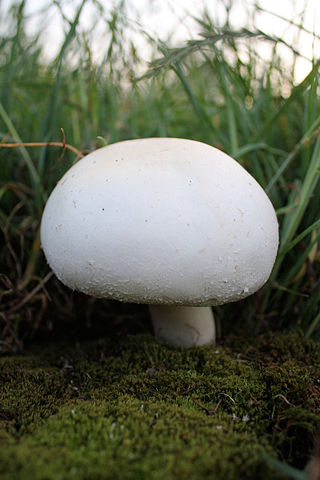
Agaricus arvensis, commonly known as the horse mushroom, is a mushroom-forming fungus of the genus Agaricus.

Agaricus campestris is a widely eaten gilled mushroom closely related to the cultivated A. bisporus. A. campestris is commonly known as the field mushroom or, in North America, meadow mushroom.
Chemical tests in mushroom identification are methods that aid in determining the variety of some fungi. The most useful tests are Melzer's reagent and potassium hydroxide.
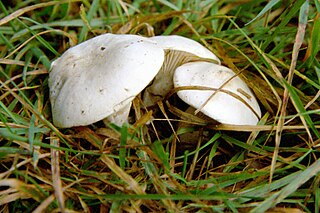
Clitopilus prunulus, commonly known as the miller or the sweetbread mushroom, is an edible pink-spored basidiomycete mushroom found in grasslands in Europe and North America. Growing solitary to gregarious in open areas of conifer/hardwood forests; common under Bishop pine along the coast north of San Francisco; fruiting shortly after the fall rains. It has a grey to white cap and decurrent gills.

Phlebopus is a genus of fungi in the family Boletinellaceae. The genus has a widespread distribution in subtropical and pantropical regions, and contains 12 species. The species are saprobic, with some possibly able to form mycorrhizae with exotic trees in certain conditions. It contains the gigantic Phlebopus marginatus, the cap of which can reach 1 m (3.3 ft) in diameter.

Secotium is a genus of fungi in the family Agaricaceae. The members of this genus are closely related to ordinary Agaricus mushrooms, but do not open out in the usual way; this has given rise to the term "secotioid" for such mushrooms in general. They are thought to form an evolutionary link between agarics and gasteroid fungi. Secotium is a widespread genus, with species that are predominantly found in warm and arid regions.
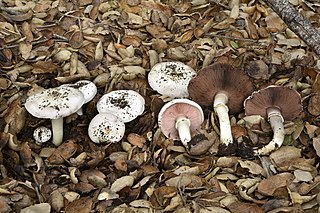
Agaricus californicus, commonly known as the mock meadow mushroom, or California agaricus, is a poisonous mushroom in the section Xanthodermati of the genus Agaricus.

Agaricus cupreobrunneus, commonly known as the copper mushrooom or brown field mushroom, is an edible mushroom of the genus Agaricus.
Paul Heinemann was a Belgian botanist and mycologist. Heinemann specialized in African mycology. In his long career, he published 435 names, including 2 families, 6 genera, 346 species, and 40 varieties. His collections of dried specimens, numbering about 7000, are preserved in the herbaria of the University Faculty of Agricultural Sciences in Gembloux and of the National Botanic Garden of Belgium, in Meise. The fungal genus Heinemannomyces was named in his honor, as were the species Agaricus heinemannianus, Marasmius heinemannianus, and Peyritschiella heinemanniana.














